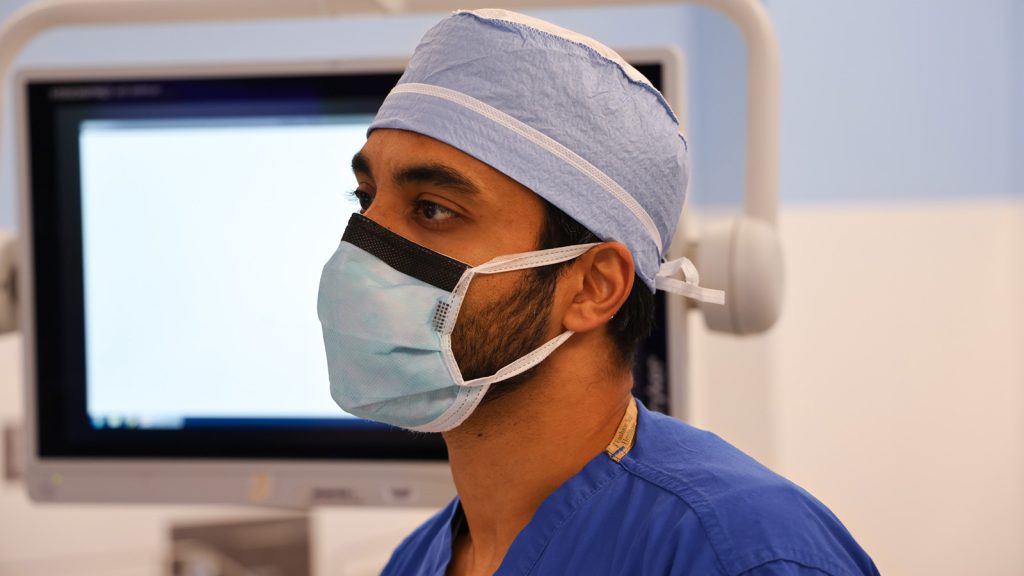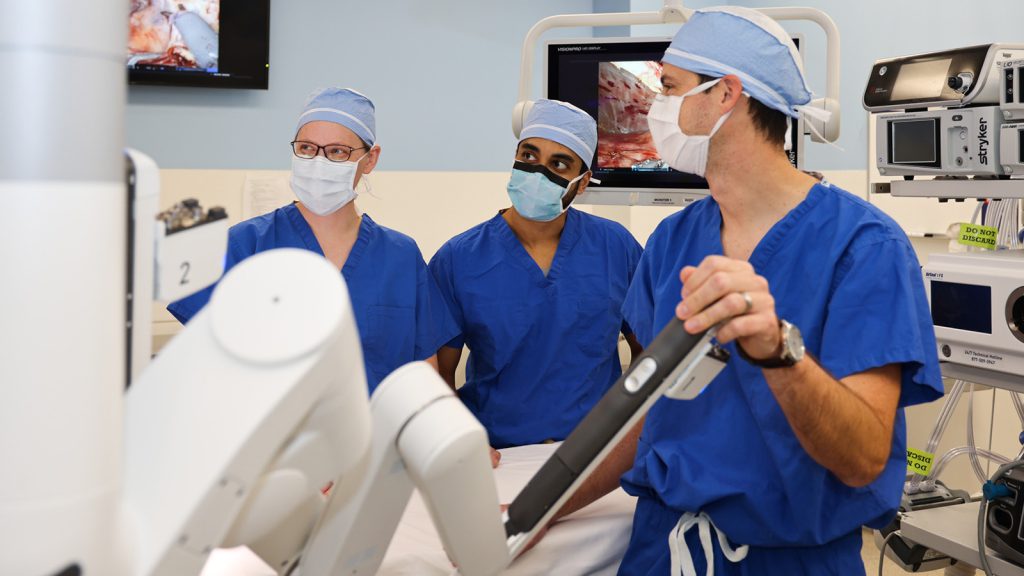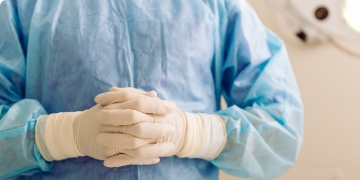
Ventral Hernias
A ventral hernia happens when the contents of the abdomen bulge through a weak spot in the muscles of the abdominal wall. There are different types of ventral hernias, including primary abdominal, umbilical, incisional and epigastric hernias.
Most ventral hernias occur in the vertical center of the abdominal wall. This means they happen above, below or at the belly button (also called the umbilicus). Ventral hernias can also happen in other parts of the abdominal wall, especially near places where you have had previous surgeries.
The abdominal wall is the muscle that covers your stomach, intestines and other organs in your abdomen. Layers of tissue, fat and skin also make up the abdominal wall.
Another name for ventral hernias is abdominal wall hernias, since this type of hernia occurs somewhere in the abdominal wall.
Ventral Hernia Types and Causes
There are four main types of ventral hernias. They are all caused by weakness in the muscles of the abdominal wall.
Ventral hernia causes and risk factors include:
- Being overweight or obese
- Frequent or chronic coughing
- Severe vomiting
- Pregnancy
- Lifting or pushing heavy objects
- Straining during bowel movements or urination
- Injuries to the bowel area
- Lung diseases like chronic obstructive pulmonary disease and emphysema, which put strain on the abdominal wall
- An enlarged prostate, which causes straining while urinating for males
- Muscle weakness caused by aging
The main differences between the types of ventral hernias are based on the location of the hernia and the cause for the weakness in the abdominal wall.
Primary Abdominal Wall Hernia
A primary abdominal wall hernia happens when the intestines or tissue bulge through the muscle at a naturally weak spot in the abdominal wall.
Umbilical Hernia
An umbilical hernia occurs near the belly button. Umbilical hernias can happen in newborns and children born with weakness in the abdominal wall. An umbilical hernia can also happen in an adult at any age.
Incisional Hernia
An incisional hernia happens when the intestines or tissue bulge through the muscle at a past incision site. These occur in areas where you have had previous surgeries.
Epigastric Hernia
An epigastric hernia happens when the intestines or tissue bulge through the muscle midline above the umbilicus. This means the hernia occurs somewhere in a straight line above your belly button.
Ventral Hernia Symptoms
The most common ventral hernia symptoms are:
- A visible bulge in the abdominal wall
- Pain, pressure, aching or burning at the hernia site
A ventral hernia may get smaller or seem to disappear when you lie down. This is sometimes called a reducible hernia. A reducible hernia may also get smaller when your doctor massages your abdominal wall.
If the hernia used to be reducible, but no longer seems to be, or if the symptoms of the hernia get worse, that could be a sign of a serious complication requiring urgent medical attention.
What are the complications of ventral hernias?
A ventral hernia can become stuck (also called incarcerated), meaning the contents of the bulge cannot be massaged back inside the abdominal wall. This can lead to serious complications.
If a hernia is stuck outside the abdominal wall, it may become strangulated. A strangulated hernia happens when blood flow to the hernia is cut off. Without blood flow, the tissues or parts of organs inside the hernia can die.
If a hernia is stuck or strangulated, this can cause intestinal obstruction and death of the strangulated intestine. This may require emergency surgery.
Strangulated hernia symptoms:
- A hernia bulge that is larger than before
- A hernia bulge that does not go back inside the abdomen
- Fever
- Redness in the area
- Sudden or severe pain
- Symptoms of intestinal obstruction, including abdominal pain, bloating, nausea and vomiting

Ventral Hernia Testing and Diagnosis
To diagnose a ventral hernia, your doctor will ask about your medical history and symptoms, perform a physical examination, and in some cases order other tests.
Many abdominal wall hernias can be diagnosed with a physical exam and medical history.
In some cases, your doctor may order imaging tests to help diagnose an inguinal hernia. Imaging tests can also help check for complications. These tests include:
- Ultrasound: a kind of test that uses sound waves to create an image of your organs
- CT scan: a kind of test that uses a combination of x-rays and computer technology to create images
- MRI: a kind of test that takes pictures of your organs and tissues without using x-rays
Ventral Hernia Treatment
Most people with ventral hernias will need surgery. A hernia will not go away on its own, and there are no nonsurgical options that will fix or repair a hernia.
Watchful waiting may be an option for some people with mild symptoms.
There are different types of hernia repair surgery, including open and minimally invasive approaches. Which type of surgery is best for you depends on your hernia, surgical history, overall health and other factors. If your doctor recommends surgery, they will discuss your surgical options and help you decide on the treatment that’s right for you.
Open Hernia Surgery
In open hernia repair surgery, the surgeon makes a cut near the hernia site to view and repair the hernia. The bulging tissue is gently put back inside the abdomen. After surgery, the surgeon typically uses stitches and mesh to close the abdominal wall.
Minimally Invasive Hernia Surgery
Minimally invasive hernia repair surgery uses smaller incisions than traditional open surgery. There are two types of minimally invasive surgery: laparoscopic and robotic surgery.
In laparoscopic surgery, the surgeon makes small cuts (each less than an inch long) in the abdomen. Small surgical tools go through these incisions to help the surgeon view and repair the hernia. The surgeon uses a thin scope with a camera to see the hernia during surgery. The bulging tissue is gently put back inside the abdomen using small surgical tools.
In robotic surgery, the surgeon uses a robot with special surgical tools to assist in the procedure. The surgeon starts by making small cuts (each less than an inch long) in the abdomen. Then, surgical tools attached to the robot go through these incisions. The surgeon sits at a console in the operating room and uses handheld controls to move the tools and perform surgery. The bulging tissue is gently put back inside the abdomen using small surgical tools attached to the robot.
After any type of hernia repair surgery, the surgeon typically uses stitches and mesh to close the abdominal wall. Synthetic mesh strengthens the closure to prevent the hernia from bulging back out.
Watchful Waiting
If an abdominal wall hernia causes mild or no symptoms, your doctor may recommend watchful waiting. This means delaying surgery and monitoring the hernia to notice any changes in symptoms or severity. It is important to see a doctor for any ventral or abdominal wall hernia. Your doctor can help you determine if watchful waiting would be safe for your hernia.
Usually, symptoms of a ventral hernia will get worse with time. Watchful waiting can delay surgery, but eventual surgical treatment is the best way to fix a hernia.
What should I expect before and after hernia surgery?
Hernia repair surgery, also called abdominal wall reconstruction, is the best way to fix a hernia and prevent it from coming back. There are steps you and your hernia care team can take before and after surgery to help you have a successful outcome.

Before Surgery
Your Washington University hernia surgeon will begin by asking about your medical history and symptoms, as well as your goals for life after surgery. This will help determine the best treatment option for your hernia.
Talking to your surgeon about your goals is an important step in deciding on treatment. Your surgeon will ask you what kinds of activities you want to return to after surgery. You and your doctor will also go over any other health conditions you have.
Before having hernia surgery, your doctor will make sure you are healthy enough for surgery. Maintaining a healthy weight and stopping smoking if you smoke can both improve your recovery after surgery. Being overweight or obese can increase the risk of recurrence (the hernia coming back after surgery). Smoking can cause complications with wound healing after surgery. Your hernia care team can help you find resources if there is anything you need to do to prepare for surgery.
General anesthesia is used in most hernia surgeries.
After Surgery
After surgery, you may have some pain or discomfort. The pain is usually mild and goes away within about 2 weeks after surgery.
Minimally invasive (laparoscopic and robotic) surgery uses smaller incisions than traditional open surgery. These techniques typically result in less pain, shorter hospital stays and faster recovery times.
After hernia surgery, many patients can go home the same day. Some people may need to stay in the hospital overnight.
Your doctor will recommend when you can safely return to your usual activities. Most people are able to return to daily activities within about 3 to 5 days after surgery. You may not be able to do any strenuous activity for about 4 to 6 weeks following ventral hernia surgery. In some complex cases, lifting and activity restrictions may last longer.
Prevention
You can take steps to prevent a ventral or abdominal wall hernia.
- Maintaining a healthy body weight can reduce the risk of a hernia caused by being overweight.
- Learning to safely exercise and lift heavy weights can reduce strain on the abdomen.
- Treating chronic coughs and chronic constipation can prevent strain on the abdominal wall.
- Following all recommendations, guidance and limitations after having surgery can reduce the risk of an incisional hernia happening near the surgical site.
Washington University Hernia Surgery
Washington University hernia surgeons provide personalized care for people with hernias. Our surgeons are specialists in minimally invasive abdominal wall reconstruction using laparoscopic and robotic surgery. Every hernia is different, so we tailor our approach for your best outcome. We are here to help you get back to your regular daily activities without the pain of a bulging hernia.


